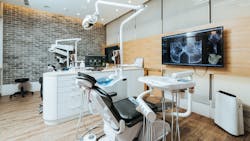Designing the dental practice of the future: Efficiency, infection control, and flow (pt. 5)
Editor's note: This article is part four in a five-part series. Following are the related articles.
- Designing the dental practice of the future (pt. 1)
- Designing the dental practice of the future: Rethinking reception (pt. 2)
- Designing the dental practice of the future: Support spaces that promote asepsis and efficiency (pt. 3)
- Designing the dental practice of the future: Operatory design for air quality and aerosol containment (pt. 4)
With more than 200,000 dentists nationwide and roughly 90% in private practice,1 there are a lot of dental facilities in the US, yet there’s no central governing authority that guides how they should be designed. Without a rule book, how can dentists ensure their spaces are designed according to best practices, taking into account all pertinent considerations? As a health-care facility designer, I know that achieving optimal flow, safety, and efficiency doesn’t just happen; it’s the result of many decisions about space utilization, access, and movement, to name a few. These decisions are layered with a dentist’s goals, job site conditions, building codes, and now, postpandemic concerns. As the final article in this five-part series, the following recommendations represent the culmination of dental design know-how and proven techniques for efficiency and infection control (with a few details to improve flow and fun).
Spatial organization 101
Organization is the antidote to chaos. It works when we arrange items in our kitchen cabinets, helps us find our way around the grocery store, and keeps us secure when entering an airport. The same goes for dental practices when similar activities are organized into three functional zones: public, clinical, and team. The public zone consists of the places where patients enter, wait, and circulate; it includes reception, the business desk, patient corridors, and restrooms. The clinical zone is where care is delivered and supported, and includes operatories, consultation, sterilization, designated clean supply storage, and the laboratory. The team zone is all about staff interaction, consisting of the business office, team room, doctor’s office, staff entrance, and staff restroom; it can also include the mechanical room, bulk storage, and dedicated space to don personal protective equipment (PPE).
“Zoning” groups spaces for similar activities together, which streamlines movement throughout the practice and makes it easier to get things done. Imagine how much stress and wasted time would occur if your practice’s sterilization center was in a far-off corner of the office? Or if you had to pass by the busy checkout counter each time you sought solitude? It’s important to not only consider the size and composition of each zone, but also how the spaces interact and transition from one to another.
Reinforcing infection control
If efficiency isn’t enough, the pandemic makes an even greater case for creating zones in the dental practice as an added layer of infection prevention. Proper spatial organization can help reduce unnecessary interactions, avoid cross-contamination, and make it easier to address air quality.
Let’s take the surgical wing of a hospital, for example. Not just anyone can mosey into an operating room, including hospital staff—and this is by design. Clinicians must first pass through a donning area where they swap their contaminated street clothes for scrubs and cover their hair and shoes with bonnets and booties. This room not only prompts required behavior, but also serves as an anteroom to transition between “dirty” public spaces and what hospitals call a “sterile corridor,” the path along which operating rooms, sterile supplies, and scrub sinks are accessed. Behind the scenes (well, above the ceiling) of this enclosed sterile area, the building’s mechanical system is working extra hard to exhaust contaminated air and replace it with clean air, so as not to compromise the sterility of supplies and equipment or cause hospital-acquired infections. The pandemic has reinforced that dental practices are not exempt from the risk of serious infection transmission, as evidenced by practices across the nation being closed for the first time in history in 2020. As we imagine the dental practice of the future, it’s time to up-level the approach to infection control by borrowing techniques from hospitals and defining spatial zones more succinctly.
Avoiding traffic jams
Spatial zoning for efficiency and infection control goes hand-in-hand with circulation through the dental practice. Circulation, or getting from point A to point B, can be an afterthought in any space design, as it’s common to focus on the rooms themselves and what goes on inside them. Many dental offices share similar problem areas that are inefficient, cramped, or uncomfortable. Now, with COVID-19 concerns, these areas have the potential to cause unnecessary traffic jams that increase the risk of cross-contamination while adding to staff and patient anxiety.
To avoid common circulation mistakes, start by ensuring that corridors are wide enough (ideally 54”-66”), and add some extra breathing room in high-traffic areas such as sterilization and checkout. Consider a combination of semiprivate checkout booths and closed checkout rooms, where sensitive financials and scheduling challenges can be discussed without creating a bottleneck. The consultation room or manager’s office can serve this dual purpose if located close to checkout. Don’t skimp on the size of sterilization and other support areas. Practices are often so focused on maximizing the number of treatment rooms that they sacrifice the necessary support space to keep the office running smoothly. Sterilization, for example, should contain a minimum of 24” of counter space per operatory. A galley-style corridor width of between five and six feet allows clinicians to work both sides of sterilization comfortably. Borrowing from hospitals once more, clean supplies should be kept in their own designated room so sterility is not compromised.
Designing for flow state
If you’ve designed or renovated a practice before, you’ve likely heard the term “flow” tossed around. You want operatory procedures to flow efficiently; your office manager wants check-in and checkout to flow easily; your designer wants to streamline patient and staff traffic flow. Flow is defined as running smoothly, or moving at a continual pace.2 I like to take this one step further by designing spaces to achieve not just flow, but flow state.
Coined by Hungarian psychologist Mihaly Csikszentmihalyi in the 1980s, flow state describes the positive psychological condition of being fully absorbed and focused on the activity you’re participating in, which creates exceedingly high levels of engagement and enjoyment.3 Have you ever gotten lost in a hobby such as golfing, playing a video game, or strumming away on your guitar, causing time to stand still? I sure have; when I’m not designing practices, writing for Dental Economics, or acting as a human jungle gym for my two small kids, I’m an avid painter. The phenomenon of this blissful, self-rewarding state led me down the path of researching flow state, which, believe it or not, can have copious benefits when tapped into at work.
There are certain conditions that influence flow state: awareness of the here and now, high concentration on the task at hand, having a sense of control, and deep connectedness.4 To encourage a flow state when I’m painting, I set up in a space where I can concentrate, make sure I have my tools right where I need them, and fill the room with the sounds of a killer album. The takeaway here is not to discount flow state when designing the practice of the future. Approach your space as a way to nourish the need to do your job, do it well, and have some fun.
REFERENCES
1. Health Policy Institute infographics. American Dental Association. https://www.ada.org/en/science-research/health-policy-institute/publications/infographics
2. Flow definition. Merriam-Webster. https://www.merriam-webster.com/dictionary/flow
3. Moore C. What is flow in psychology? Definition and 10+ activities to induce flow. PositivePsychology.com. December 10, 2020. https://positivepsychology.com/what-is-flow/
4. Houston E. 11 activities and exercises to induce a flow state (+ 6 examples). PositivePsychology.com. December 10, 2020. https://positivepsychology.com/flow-activities/
About the Author
Melissa Sprau, NCIDQ
Benco director of design Melissa Sprau, NCIDQ, brings over a decade of commercial and hospital design experience to the dental industry. As a licensed interior designer with a background in health care facilities planning and design, her approach combines best practices for health and safety with the details required to support positive patient and caregiver experiences. Sprau coaches practitioners to discover their brand and infuse it into the built environment, aligning quality of space with quality of care.
Updated January 14, 2020

